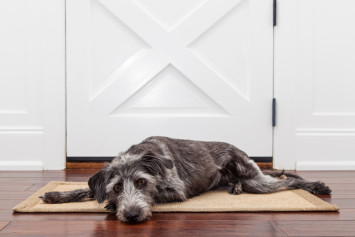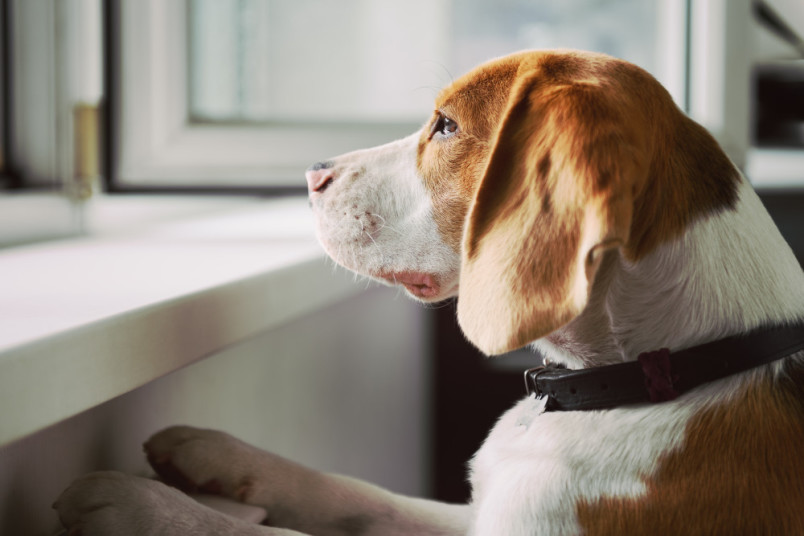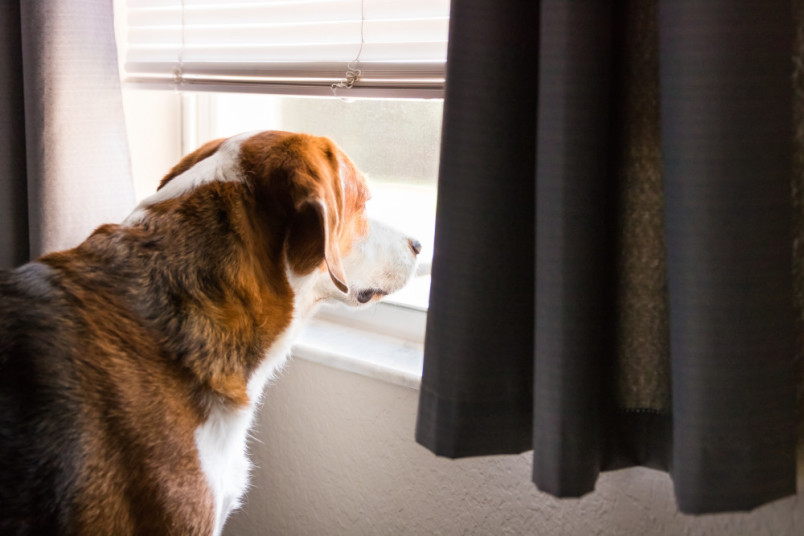
It may be hard to imagine your friendly, fun-loving pooch experiencing anxiety. While most dogs can make a fun game out of a chore, others can experience dog anxiety that can completely change their behavior from one minute to the next. Anxiety in dogs can manifest in ways similar to human anxiety, or it can look completely different. Knowing what dog anxiety looks like can go a long way in getting your dog the help they need to not only feel better but to decrease the anxious behaviors that may get in between you and your canine companion.
Signs of Dog Anxiety
If only dogs could tell us how they are feeling, we might be able to get to the bottom of their anxiety with a little more ease. Instead, we must base our diagnosis on other clues. Fortunately, most dogs readily display these signs of anxiety, you just have to know what to look for. Some of those signs include:
Aggression: Dogs may become overly aggressive, especially over their territory or resources. They may bark, growl, or even nip at people or animals that come near your yard or their food bowl. They may show aggression towards people or animals they don’t know.
Submission: On the other hand, an anxious dog may be overly submissive and clingy. They may jump up on you, try to lick your or otherwise not let you out of their sight, especially if they heard a loud noise, saw a stranger, etc.
Destructive behavior: Rather than being able to do something about their anxiety, some dogs may become destructive, possibly to get some of those feelings out. They may chew or tear up their bed, furniture, rugs, or curtains, not to get back at you but to self-soothe.
Urinating or defecating in the house: Anxiety may present itself in the form of potty accidents in your house. Your dog isn’t being vengeful, they’re just overwhelmed.
Whining, pacing, panting, trembling, sleeping more, not eating, depression, lack of interest in activities, hiding, repetitive behaviors like licking a paw, and drooling may all indicate anxiety in dogs as well.

Causes of Dog Anxiety
Dog anxiety seems to stem from both genetics and environmental factors. This means some breeds and lineages may be more prone to anxiety overall, but certain experiences in a dog’s life can shape their behaviors as well. The potential causes of a dog’s anxiety should come as no surprise, but that doesn’t mean they’re easy to diagnose. Generally, anxiety in dogs typically stems from one of these main areas.
Fear-Related Anxiety
Fear-related anxiety is just that—a dog is scared by something, and it leads to anxious behaviors. That fear could be of loud noises, strangers, other animals, and certain places or things. Thunderstorms, fireworks, gunshots, new dogs, and slick flooring are all common anxiety triggers.
Separation Anxiety
Most pet parents never question their dog’s devotion to them, there’s just an unspoken bond. However, some dogs take this bond to the extreme and will show anxious behaviors whenever you’re not with them. Separation anxiety in dogs can be especially frustrating because dogs can become destructive as a result, causing some dog parents to return home to a shredded living room rug.
Age-Related Anxiety
“Doggie dementia” or canine cognitive dysfunction syndrome is another cause of anxiety in dogs. This is brought on by age-related degeneration of the brain that can lead to confusion, forgetfulness, and changes in how they react with you. Any of these issues can bring on anxiety as a dog may have a hard time feeling comfortable with these changes.

Treating Dog Anxiety
The treatment of anxiety in dogs should always begin with a veterinary visit. It’s important that you understand that anxiety is rarely a stand-alone issue, there are often underlying factors at play as well. Your veterinarian will be able to rule out medical causes of anxiety and help you through an approach to treat it. Depending on the severity and cause of a pup’s anxiety, more than one approach may need to be taken.
Training Strategies for Anxiety
The most common training strategies used for dog anxiety are desensitization and counterconditioning. These two methods can be used separately but are more successful when used together. Basically, the idea is to help dogs reduce their anxious response to a trigger, whether that be a loud noise or you leaving for work, and to instead associate that trigger with something positive. Desensitization and counterconditioning take a lot of time and patience with you needing to make gradual changes over time. Don’t be afraid to enlist the help of a professional trainer or dog behavioralist for this.
Anxiety Medications and Natural Therapies
Treating dog anxiety also often includes the use of medications. These products should not be used alone. You’re likely to have greater success when combining medications with training to help your dog overcome their anxious behaviors. Now, it’s important that you never give your dog any medication or natural therapy without talking to your veterinarian first. They will be able to decide what’s best for your pup and what the proper dose should be.
Some potential medications for dog anxiety include:
Selective serotine reuptake inhibitors (SSRIs) and antidepressants may be used short or long-term for dogs with most types of anxiety.
Benzodiazepine may be added in for dogs with specific fears, such as thunderstorms or veterinary visits, to be given before the event occurs to help reduce the associated anxiety.
Selegiline may help dogs with cognitive dysfunction syndrome.
Natural products like pheromones, CBD oil or aromatherapy may be of some benefit, but it’s important to know that these methods aren’t well regulated, so you’ll need to pay strict attention to your veterinarian’s recommendations.
Calming or anxiety vests may provide some dogs relief from anxiety related to fearful situations.
Managing Anxiety in Specific Situations
Medications and training help to treat a dog’s anxiety overall, but there are some extra things that you can do in specific situations.
Separation anxiety can be helped by gradually getting your dog used to your absence. Start by leaving the room and build up to leaving for the day. Give your dog a toy or puzzle treat when you leave and provide them with lots of attention when you get home.
Resource guarding means that some dogs don’t like to share. Start by giving every pet their own food and water bowl, bed, toys, etc. Give them all one-on-one attention and then slowly start to combine activities with lots of rewards for good behavior. While alleviating competition reduces stress, for anxious dogs, it can also create a safer space where they don't feel the need to fiercely guard resources, lowering overall anxiety levels.
Territorial aggression can be helped through redirection. When your pup becomes agitated with a neighbor dog in their sights, give them a toy or play a game so that they forget who they were upset with. Redirecting their attention with playful activities during triggers can help them manage their anxieties and prevent unwanted behaviors.
Sound sensitivity is best helped through desensitization and providing a safe place. Be sure to comfort your pup with affection or redirection as well.
Cognitive dysfunction syndrome can be managed by keeping a strict schedule and gradual changes when necessary. Don’t go rearranging the furniture or skipping your dog’s walk as these can increase anxiety.
Preventing Anxiety in Dogs
Part of how to treat anxiety in dogs deals with preventing it in the first place. The better you can read your dog’s body language related to anxiety and the more you understand their triggers, the more able you will be to avoid or to at least prepare your dog for potentially anxiety-causing situations. This may mean giving them medication, applying a calming vest, or giving them a safe space to retreat to as well as some much-deserved affection.
You’ll also want to make sure your dog is properly socialized. Socialization is easier done as a puppy but can happen at any age. Get your pup exposure to as many different people, places, animals, and things as possible so that they’re more comfortable with things they don’t recognize or understand.
While you’re socializing your pup, be sure you’re also teaching them some obedience. Having some tried and true commands to listen to when anxious can help a dog feel more comfortable in any situation. Good commands for them to know are sit, down, stay, and come.
Finally, make sure your dog gets adequate exercise and attention every day. Pent up energy and feeling neglected can breed anxious behaviors. Also be sure you’re providing a high-quality diet and getting regular veterinary care to help catch issues while they’re small.

Importance of Consistency and Predictability
Part of a dog’s anxiety may come from not knowing what to expect. You can help curb that by setting a schedule or routine and then sticking with it. Feed and walk them at the same times every day. Try to leave or get home at the same time and be sure to give them one-on-one time every day.
You should also provide them with a safe space. This will be an area filled with familiar items, such as a bed and toys, that they can retreat to when they feel anxious. You may need to take them to their safe space the first few times and spend some time with them there so that they get the idea. A crate makes a great option. You’ll want to use these crate training tips to help them feel most comfortable.
Seeking Professional Help for Canine Anxiety
Again, your veterinarian should be your first line of defense when it comes to an anxious dog. They will start by ruling out medical causes for anxiety and can help you find the right behavioral help and medications to improve your dog’s quality of life with anxiety.
From there, look into professional training. An animal behavioralist or professional trainer can help customize training methods to best suit your dog’s needs. They can also give you tips on socialization and obedience training to round out your treatment approach.
Another big consideration in managing your dog’s anxiety is dog insurance. Ever wonder why dog insurance is such a game-changer? From behavioral consultations to specialized medication, anxiety treatment can add up. Dog insurance can reimburse a significant portion of these expenses, reducing financial stress and allowing you to focus on your dog's well-being. By investing in a plan before any anxiety symptoms appear, you ensure that your furry friend's future worries are covered. That means, when anxiety does strike, you'll be financially prepared to explore all treatment options. We all know that dog costs can be high, so having insurance to help offset some of those charges is more than welcome.
For example, here at the Embrace office, we have a dog named Maysie. Maysie happens to suffer from anxiety that is best treated using sertraline, or Zoloft, and visits with a veterinary behavioralist, both of which are covered under her dog insurance policy that her owner Diana purchased before Maysie was diagnosed with anxiety. While a lot of pet insurance policies will cover the necessary medications, not all of them will chip in for behavioral training. As you can imagine, having this treatment method covered comes as a huge relief to Diana. Choosing the right pet insurance policy is important but getting it early on, before you need it, is key.